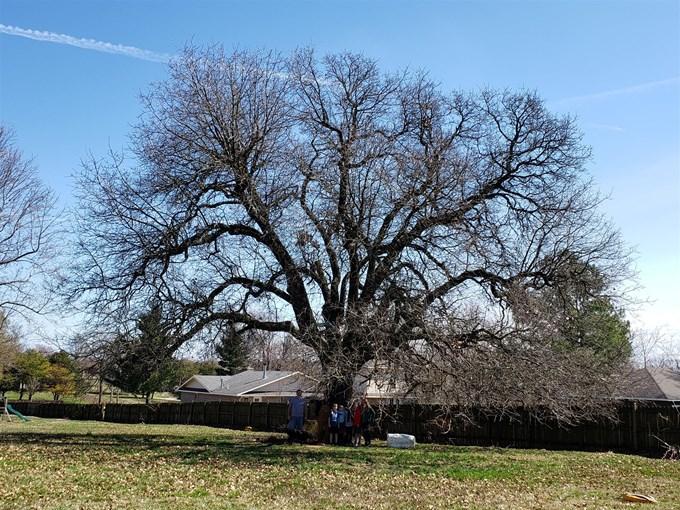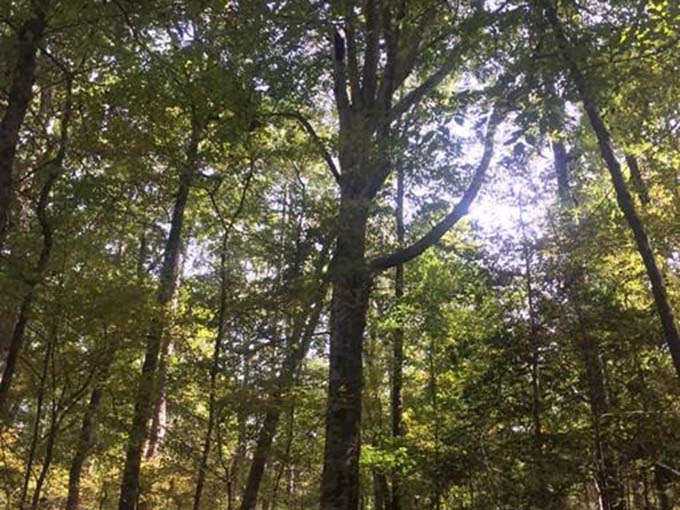Forestry
Protecting Arkansas’s forests, and those who enjoy them, from wildland fire and natural hazards while promoting rural and urban forest health, stewardship, development, and conservation for all generations of Arkansans
Agriculture / Forestry / Champion Trees
Champion Trees
The Arkansas Champion Tree Program is a recognition program for the largest trees of each tree species in Arkansas.
Arkansas is renowned for its scenic, natural beauty and abundant forested areas. The trees of this great state are pieced together across a varied landscape and offer huge diversity. Champions are unique from one another in size, width, and even color, as they represent entirely different species from one tree to the next. It’s important to remember that not all Arkansas Champions are necessarily tree giants; rather, they are the largest for that tree species. For example, the Champion ginkgo tree is much smaller than the Champion baldcypress tree They are equally magnificent, however, in their own unique ways.
If you have a tree you believe is the largest of its species, contact the Forestry Division using the contact form, or call your local Forestry Division office. You may also send a nomination form directly to Harold Fisher at 20 Industrial Boulevard, Greenbrier, AR 72058. Send questions to harold.fisher@agriculture.arkansas.gov.



Champions of the Arkansas Champion Tree Program
Arkansas's Champion Tree Program has grown in popularity and recognition thanks to the shared interest of Arkansas landowners, the work of Forestry Division personnel across the state, and the work of two special "champion" visionaries: Linda Williams Palmer and Peggy Clark.
Linda Williams Palmer, Hot Springs artist and long-time Arkansan, was so inspired by Arkansas Champion Trees that she created an entire collection of artwork, featuring large, detailed, colored pencil-drawn images to document and artistically interpret selected Arkansas Champions. Palmer’s exhibit, "Arkansas Champion Trees: An Artist’s Journey," has been selected for numerous juried exhibitions and collections across the state. Palmer’s work has captured in time the intricate detail and splendor of each Champion Tree featured, so that even as they age, their memory does not. An Arkansas Arts Council grant, along with donations from Plum Creek and Domtar, enabled the Arkansas Committee of the National Women in the Arts to make Palmer’s series available to 16 venues across the state from 2012 to 2014. View the drawings on Linda's website.
Peggy Clark, Arkansas Forestry Association (AFA) Board Member, Ross Foundation Trustee, and former Commissioner with the Arkansas Forestry Commission, saw Linda’s exhibit and was inspired — how could Champion Trees be better identified as Champions of their species by the public? Peggy forged a cooperative effort between the Ross Foundation, AFA, Arkansas's Forestry Division, and the U.S. Forest Service to create hand-crafted, native stone monuments to commemorate and identify Champion Trees. Stonemason Jack Culpepper of Garvan Woodland Gardens worked with partners to mount Champion Tree plaques on stones identifying the tree species and its status as a Champion Tree. Thanks to Ms. Clark’s ingenuity and the wonderful partnerships begun by participation and support from the Ross Foundation, many Champion Trees are now easily visible and handsomely marked.
In 2014, the Arkansas Educational Television Network (AETN) created a documentary film, “Arkansas Champion Trees,” about Palmer’s work and exhibitions. The film includes historical background from the landowner of each featured tree, a forester’s perspective on measuring and documenting trees (told by Forestry Division Forester Matthew Voskamp), and information on the stone monuments. This film has gained national attention and has won several awards. AETN produced an excellent guide for educators, the Champion Trees Educator's Guide, to go along with the documentary.
The Arkansas Committee of the National Museum of Women in the Arts, with support of Entergy Arkansas grants and a grant from the School of Forest Resources at the University of Arkansas at Monticello, also produced classroom materials to bring Palmer’s collection to Arkansas students. Materials include complete lesson plans and posters to accompany each work of art. The materials are free and can be found online at the Arkansas Forestry Association website via this link.
Measuring Champion Trees
Trees are measured in three dimensions: trunk circumference, tree height, and average crown spread. Circumference is measured at 4½ feet from ground level. (Alternatively, sometimes diameter is measured and then converted back to circumference.) The formula below is used nationwide as the official calculation of a champion tree:
circumference (measured in inches)
+ height (measured in feet)
+ one-fourth of the average crown spread (measured in feet)
= Bigness Index
Management of the National Champion Trees Program, which maintains a list of the biggest tree from across the entire United States for each species is currently transitioning from American Forests to The University of Tennessee. You can view the listing of National Champion Trees as of 2021 on the American Forests website, and the next National Register of Champion Trees will be published in 2024 on a date to be set by the University of Tennessee
How to Nominate a Champion Tree
Arkansans from anywhere in the state may nominate a tree for measurement as a possible new champion (nomination form). For a tree to be eligible for nomination it must be a native tree to Arkansas or non-native and naturalized. In addition, hybrids, cultivars, ornamentals, and unclassified varieties are excluded. Local forestry officials use the Bigness Index discussed above to evaluate tree measurements. If the Bigness Index of a nominated tree is larger than that of the current state champion, the nominated tree then becomes the new champion for its species. In some cases, two or even three trees may be named co-champions if their Bigness Index values are within 3% of each other.
Arkansas Champion Trees
View a Map of the Champion Trees (The map of Champion Trees is currently in the process of being updated. The below lists of Champion Trees by County and Champion Trees by Species contain the most up-to-date information on current Arkansas Champions.)
List of Champion Trees by County
- American Basswood (Tilia americana)
- American Beech (Fagus grandifolia)
- American Chestnut Hybrid (Castanea dentata-X-mollissima)
- American Elm (Ulmus americana)
- American Holly (Ilex opaca)
- American Hornbeam (Carpinus caroliniana)
- American Smoke-Tree (Cotinus obovatus)
- American Sycamore (Platanus occidentalis)
- Amur Corktree (Phellodendron amurense)
- Arborvitae (Thuja occidentalis)
- Arkansas Oak (Quercus arkansana)
- Ashe Juniper (Juniperus ashei)
- Baldcypress (Taxodium distichum)
- Bitternut Hickory (Carya codiformis)
- Black Cherry (Prunus serotina)
- Black Hickory (Carya texana)
- Black Locust (Robinia pseudoacacia)
- Blackjack Oak (Quercus marilandica) Co-Champion Pulaski County
- Blackjack Oak (Quercus marilandica) Co-Champion Searcy County
- Black Oak (Quercus velutina) Co-Champion Independence County
- Black Oak (Quercus velutina) Co-Champion Washington County
- Black Walnut (Juglans nigra)
- Black Willow (Salix nigra)
- Black Gum (Nyssa sylvatica) Co-Champion Woodruff County
- Black Gum (Nyssa sylvatica) Co-Champion Sharp County
- Blue Ash (Fraxinus quadrangulata)
- Boxelder (Acer negundo)
- Bur Oak (Quercus macrocarpa) Co-Champion Madison County
- Bur Oak (Quercus macrocarpa) Co-Champion Washington County
- Carolina Buckthorn (Frangula caroliniana)
- Cedar Lebanon (Cedrus libani)
- Cherrybark Oak (Quercus pagoda)
- Chickasaw plum (Prunus angustifolia)
- China-Fir (Cunninghamia lanceolata)
- Chinese Chestnut (Castanea mollissima)
- Chinkapin Oak (Quercus muehlenbergii)
- Common Persimmon (Diospyros virginiana)
- Crapemyrtle (Lagerstroemia indica)
- Cucumbertree (Magnolia acuminata)
- Dawn Redwood (Metasequoia glyptostroboides)
- Common Serviceberry (Amelanchier arborea)
- Devil's Walking Stick (Aralia spinosa)
- Durand Oak (Quercus durandii)
- Eastern Cottonwood (Populus deltoides)
- Eastern Hemlock (Tsuga canadensis)
- Eastern Hophornbeam (Ostrya virginiana)
- Eastern Redbud (Cercis canadensis)
- Eastern Redcedar (Juniperus virginiana)
- Eastern White Pine (Pinus strobus)
- English Walnut (Juglans regia)
- Fig (Ficus carica)
- Flowering Dogwood (Cornus florida)
- Ginkgo (Maidenhair) (Ginkgo biloba)
- Green Ash (Fraxinus pennsylvanica) Co-Champion Saline County
- Green Ash ( Fraxinus pennsylvanica) Co-Champion Benton County
- Gum Bumelia (Bumelia lanuginosa)
- Hackberry (Celtis occidentalis) Co-Champion Boone County
- Hackberry (Celtis occidentalis) Co-Champion Washington County
- Hawthorn (Crataegus)
- Honey Locust (Gleditsia triacanthos)
- Kentucky Coffeetree (Gymnocladus dioicus)
- Live Oak (Quercus virginiana)
- Loblolly Pine (Pinus taeda)
- Longleaf Pine (Pinus palustris)
- Maple Leaf Oak (Quercus acerfolia)
- Mexican Plum (Prunus mexicana)
- Mountain Silverbell (Halesia tetraptera)
- Northern Catalpa (Catalpa speciosa)
- Northern Red Oak (Quercus rubra)
- Norway Spruce (Picea abies)
- Nutmeg Hickory (Carya myristicaeformis)
- Nuttal Oak (Quercus texana)
- Oriental Persimmon (Diospyros kaki)
- Ohio Buckeye (Aesculus glabra)
- Osage-Orange (Maclura pomifera)
- Overcup Oak (Quercus lyrata)
- Ozark Chinquapin (Castanea ozarkensis)
- Pagoda Dogwood (Cornus alternifolia)
- Pawpaw (Asimina triloba)
- Pecan (Carya illinoinensis)
- Persian Ironwood (Parrotia persica)
- Pignut Hickory (Carya glabra)
- Post Oak (Quercus stellata) Co-Champion Lincoln County
- Post Oak (Quercus stellata) Co-Champion Pike County
- Post Oak (Quercus stellata) Co-Champion White County
- Red Buckeye (Aesculus pavia)
- Red Maple (Acer rubrum)
- Red Mulberry (Morus rubra)
- River Birch (Betula nigra)
- Roughleaf Dogwood (Cornus drummondii)
- Sand Post Oak (Quercus margarettae)
- Sassafras (Sassafras albidum)
- Sawtooth Oak (Quercus acutissima)
- Shagbark Hickory (Carya ovata)
- Shingle Oak (Quercus imbricaria)
- Shortleaf Pine (Pinus echinata)
- Shumard Oak (Quercus shumardii)
- Siberian Elm (Ulmus pumila)
- Silver Maple (Acer saccharinum)
- Slash Pine (Pinus elliottii)
- Slippery Elm (Ulmus rubra)
- Southern Catalpa (Catalpa bignonoides)
- Southern Magnolia (Magnolia grandiflora)
- Southern Red Oak (Quercus falcata)
- Sparkleberry Tree (Vaccinium arboreum)
- Spruce Pine (Pinus glabra)
- Staghorn Sumac (Rhus typhina)
- Sugar Maple (Acer saccharum) Co-Champion Benton County
- Sugar Maple (Acer saccharum) Co-Champion Washington County
- Sugarberry (Celtis laevigata)
- Sweetbay Magnolia (Magnolia virginiana)
- Swamp Chestnut Oak (Quercus michauxii)
- Toothache Tree (Zanthoxylum clava-herculis L.)
- Umbrella Magnolia (Magnolia tripetala)
- Water Hickory (Carya aquatica)
- Water Oak (Quercus nigra) Co-Champion Independence County
- Water Oak (Quercus nigra) Co-Champion Lee County
- Water Tupelo (Nyssa aquatica)
- Western Soapberry (Sapindus drummondii)
- White Ash (Fraxinus americana)
- White Oak (Quercus alba) Co-Champion Perry County
- White Oak (Quercus alba) Co-Champion Clark County
- Willow Oak (Quercus phellos)
- Winged Elm (Ulmus alata)
- Winged Sumac (Rhus copallinum)
- Yaupon Holly (Ilex vomitoria)
- Yellow Poplar (Liriodendron tulipifera)
- Yellowwood (Cladrastis kentukea)
Champion Tree Vacancies
- Bigleaf Magnolia (magnolia macrophylla)
- Bluejack Oak (Quercus incana)
- Butternut (Juglans cinerea)
- Carolina Ash (Franxinus caroliniana)
- Carolina Cherrylaurel (Prunus caroliniana)
- Cottonwood, Swamp (Populus heterophylla)
- Fringetree (Chionanthus virginicus)
- Mockernut Hickory (Carya tomentosa)
- Possum Haw (Ilex decidua)
- Red Hickory (Carya ovalis)
- Sonderegger Pine (Pinus x Sondereggeri)
- Sweet Gum (Liquidambar styraciflua)
- Sweet-leaf Horse Sugar (Symplocos tinctoria)

